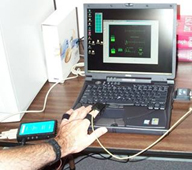DARPA Human Identification at a Distance (HID)
 |
Science Applications International Corporation (SAIC) teamed with VRMC to develop and validate new, non-imaging biometrics based on dynamic physiological data, including ECG, pulse oximetry, blood pressure, and respiration. The team developed an extensive protocol to ensure a consistent experience across all subjects independent of age, gender, or ethnicity. Our experimental design included sampling a heterogeneous population. By monitoring the subjects for presence during the testing session, the team was able to take the subjects through multiple states of anxiety by performing a variety of project-related tasks. New signal processing methods were developed to analyze the physiological data, extract features, assess variability across subjects and tasks, and perform classification analysis.
In addition, SAIC was designated to develop the Human ID database that encompasses the information generated by the entire Human ID Program and to implement and host a set of face recognition algorithms to support research and testing. Dr. Mark Wiederhold, as an employee of SAIC, was the principal investigator for this project. VRMC now has an exclusive license to this technology, and is in discussions with a number of investment groups to develop an inexpensive device that could be used for screening. The paper publishing the results of the study, “ECG to identify individuals,” was selected by the SAIC Executive Science and Technology Council for a 2005 publication prize, and the project resulted in U.S. Patent No. 6993378, Identification by Analysis of Physiometric Variation, Mark D. Wiederhold et al. Recently, the study was featured in the Fall/Winter 2006 edition of SAIC Magazine: “Researchers such as Israel, Irvine, and Wiederhold have helped make SAIC a leader in developing and deploying new biometric technologies.”
![]()
